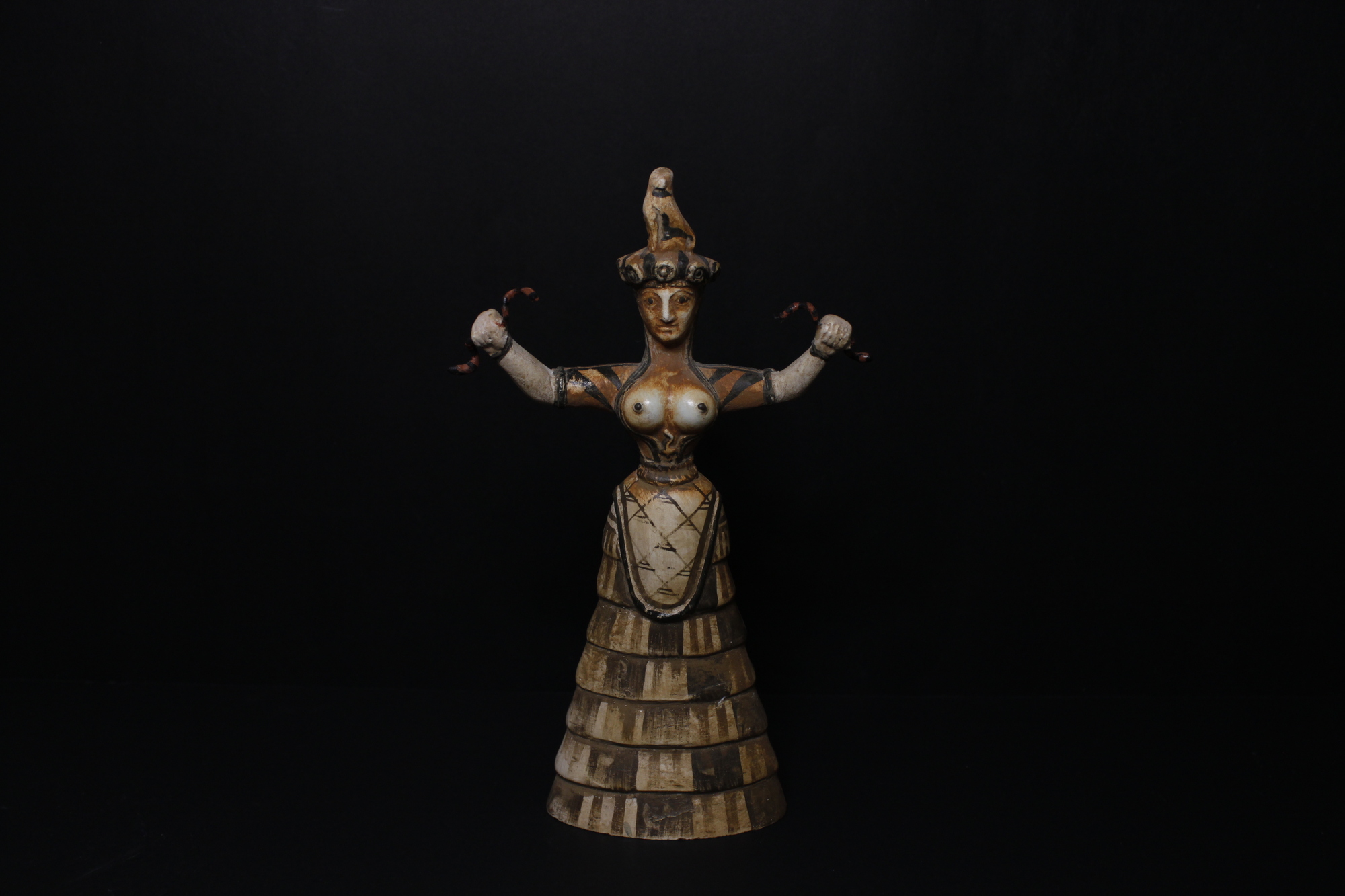Re-examining Archaeological Contexts: Minoan Snake Goddess
This striking figure is one of the most recognizable pieces of art to come out of Minoan civilization. Despite its fame, the true nature of the statue remains unknown.
Conventional Interpretations:
Author: Alysa Sara Levy
Date: March 10, 2023
Found in 1903 during the excavation of the Palace at Knossos by Sir Arthur Evans, the Minoan Snake Goddess is an artefact shrouded by mystery.
The figurine was made using an ancient ceramic technique called ‘faience’. Similar to other methods of making ceramics, this technique consisted of firing a material called silica in a kiln to form a shiny finished piece. The figure is often interpreted as a goddess or priestess, as certain features including the garments and the exposure of the breasts are similar to other depictions of Minoan religious figures.
Another prominent feature of the artefact are the two snakes that she holds in her hands. Snakes are symbolic for the renewal of life, as they continuously shed their skin. Snakes were also later associated with Asclepius, the god of healing, as it was believed that the snake whispered the secrets of healing and resurrection to him. Snakes were also thought to symbolize protection, leading some to believe that the figurine safeguarded the home. However, some scholars believe that the goddess is a catholic deity, (meaning a deity associated with the underworld), due to the fact that snakes also represented death and were thought to be guardians of the underworld.
The cat, resting on the goddess’s head, has led to the association of the goddess with death. Cats in ancient Greece were occasionally associated with Hecate, the goddess of death, darkness, and witchcraft. This association creates an interesting parallel to the snake goddess, as Hecate was sometimes depicted holding snakes.
The Minoan Snake Goddess is one of the most famous images from Minoan Civilization. Throughout history this figurine has fascinated scholars, but recent research shows that her origins may be more dubious than we think.
Controversies and Doubt:
Author: Wren Bell
Date: March 10, 2023
Like many other ancient artefacts, this figurine was found in multiple pieces. It was then assembled by Arthur Evans, who imposed his own interpretation on the figurine. The left arm and the head are reconstructions, while the headdress and the cat-figure on top were found separately and were added later.
These reconstructions pose a problem to the common interpretations of the artefact. For example, a common theory assigns her the role of ‘mistress of animals’ because of the snakes in her hands and the cat on her head. However, there is no evidence that the cat-figure originally belonged to the statue, since her head is a complete reconstruction. The figurine is also often thought to represent an unknown Chthonic deity, because of the snakes that she holds very prominently in her hands. However, modern interpretations doubt that these objects are even meant to represent snakes, as their patterns may be more representative of rope or twine.
It is important to be mindful of our interpretations of this figurine. The man who was in charge of the dig, Arthur Evans, is notorious among scholars for his questionable archaeological practices. So far, there has been minimal research based on the original statue. The case of the Minoan Snake Goddess is an excellent example of why we should be aware of what we see as fact. Instead of basing knowledge on the faulty interpretations of the past, we must look to future research to further our understanding of this fascinating artefact.
Bibliography:
Bonney, E. M. 2011. “Disarming the Snake Goddess: A Reconsideration of the Faience Figurines from the Temple Repositories at Knossos.” JMA 24:171-190.
Boze, D. 2016. “Creating history by re-creating the Minoan Snake Goddess.” JAH 15:1-31.
German, S. “Snake goddess | minoan.” Khan Academy. https://www.khanacademy.org/humanities/ancient-art-civilizations/aegean-art1/minoan/a/snake-goddess
Witcombe, E. 2000. “Women in the Aegean: Minoan Snake Goddess.” Art History Resources. https://arthistoryresources.net/snakegoddess/crete.html
Vasiloudis, D. 2022, 26 August. “The Mysterious Minoan ‘Snake Goddess’ of Crete.” Greek Reporter. https://greekreporter.com/2022/08/26/minoan-civilization-crete-snake-goddess/
“The Snake Goddesses” Heraklion Museum. https://www.heraklionmuseum.gr/en/exhibit/the-snake-goddesses/
Trckova-Flamee, A. 2000, 19 February. “Minoan Snake Goddess.” Encyclopedia Mythica. https://pantheon.org/articles/m/minoan_snake_goddess.html
“Snakes in Religion and Ancient Greek Mythology.” Greece High Definition. https://www.greecehighdefinition.com/blog/snakes-in-religion-and-ancient-greek-mythology
“Snake Goddess.” Brooklyn Museum. https://www.brooklynmuseum.org/eascfa/dinner_party/place_settings/snake_goddess
Tsoucalas, G., and Androutsos, G. 2019. “Asclepius and the Snake as Toxicological Symbols in Ancient Greece and Rome.” In Toxicology in Antiquity, edited by P. Wexler, 257-265. Academic Press. https://www.sciencedirect.com/science/article/pii/B9780128153390000172#:~:text=Since%20antiquity%2C%20the%20snake%20has,of%20both%20medicine%20and%20toxicology.
Mark, J. 2012, 17 November. “Cats in the Ancient World.” World History Encyclopedia. https://www.worldhistory.org/article/466/cats-in-the-ancient-world/ “Hecate” Hellenica World. https://www.hellenicaworld.com/Greece/Mythology/en/Hecate.html

